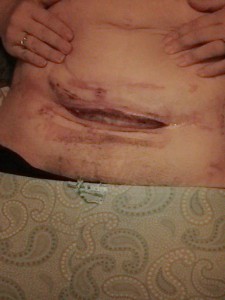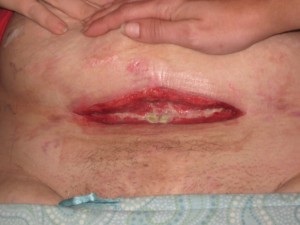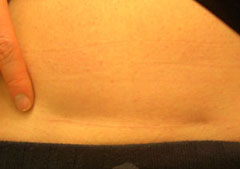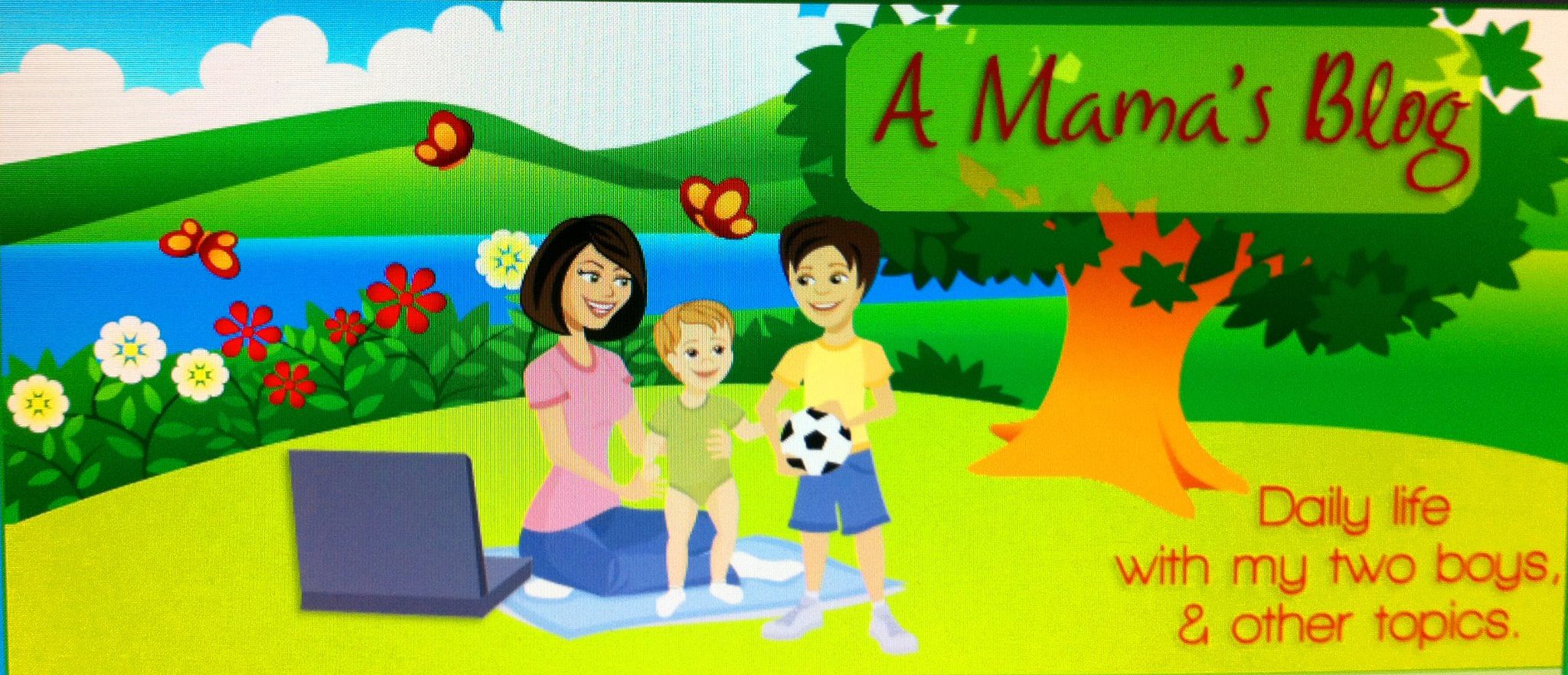As I thought about it, there were so many different angles to take. I thought about writing a very detailed researched post, but you can find a lot of those by doing a Google search on C-sections. I decided in the end, I was going to write what comes naturally from my personal research and experience of having a C-section.
My intent for writing this post is to convey the reality, which is not often mentioned, of women, their new babies, and families, endure from C-sections. It is not meant to judge or make any mother feel bad who has had a C-section. I write a lot of the things that I wished I had known before hand about C-sections, which I was not told. This post is only meant to inform, and bring to light, issues involved with C-sections, that as a woman, and a mother I seldom hear anyone (doctors included) talk about in our society.
I had a C-section with my first birth, with Ryan, only because he was a breech baby, and refused to turn. I wasn’t very informed on other alternatives for turning breech babies at the time, other than the external version, and accepted having a C-section was the only way to give birth to my baby.
Unfortunately, it pretty much WAS my only alternative. I did not feel comfortable having a home birth being a first time mother, with a breech baby. Not to mention, there were zero doctors in my area who would attend the birth of a breech baby. This is despite living in a college area, with a number of top rated medical facilities. So we agreed to the C-section, but really what choice did we have?
It has always bothered me more alternatives are not available for birthing breech babies. I did not want a C-section, but it was my only option. Even a home birth isn’t always an option- in several states (mine included), it is actually against the law for a midwife to attend a breech birth! This isn’t to say it isn’t done, but if you know ahead of time your baby is breech, this could be problematic in finding a midwife who is comfortable attending a breech birth, and possibly be in violation of the law, and thus be putting her certifications and her practice in jeopardy.
Finding an OB these days, who will deliver a breech baby, is a joke at best- even though as I found out later, delivering breech babies vaginally is very safe, in the majority of situations. In my opinion, this is a HUGE failure in the medical community to have only one option for a mother facing a breech birth- an automatic C-section.
C-sections are MAJOR abdominal surgery. The pain is agonizing. I never experienced greater pain in my life, than after my surgical C-section. Even going through natural labor and contractions with a VBAC (vaginal birth after Cesarean) birth of my second child for eleven hours, the pain was not as bad as it had been with the C-section.
The best way I can describe it is imagine your most painful, intense, contraction, and multiply it by at least 50 to 100%, depending on your pain tolerance. Now, realize the pain does not go away, after 30 seconds or a minute like the pain during contractions does. It is constant and never-ending. That level of pain is with you for DAYS (not seconds or minutes). Imagine your insides feeling like they are going to split open for several weeks, after the surgery, every time you laugh, cry, sneeze, get out of bed, stand up, or move too fast.
- Media Portrayal of C-Sections
It is also very disturbing to me how some avenues of the media, and celebrities portray C-sections. I have seen on numerous TV shows- including a prime time, number one show, (named Grey’s Anatomy, to be specific), where women who refuse a C-section, because they desire to have a NORMAL, vaginal birth, are portrayed as fanatic, and ridiculous. There is another show, The Baby Story, which shows many elective C-section births.
As a new mother-to-be, and even before I was pregnant, I watched The Baby Story. In my case, seeing so many C-section births, almost made it seem like it was a normal, healthy, alternative to giving actual birth. I NEVER saw the downside: pain, infections, and inability to get back to regular life after a C-section, shown on The Baby Story.
It is almost glamorized by the media when a famous celebrity has a C-section. “Too posh to push,” is how they sum it up. Whether that is the case or not, it is misleading to millions of women, who are faced with the same decision. What is NEVER mentioned is even if a celebrity chooses to have an elective C-section; she has resources available to her, which a normal woman does not. The celebrity can hire nurses, nannies, chefs, and cleaning services to take over for her while she recovers from surgery, when an average woman cannot. The strain and time it takes to recover from a C-section puts the average family under enormous stress.
Yet, the media continues to glorify and glamorize C-sections. It even seems like they make a special point to say, “Actress A had her baby (or gave birth), born by Cesarean section.” I have yet to see, hear, or read, “Actress A had her baby, born by normal, vaginal birth.”
I certainly never gave much thought to what really was involved with a C-section. I honestly thought, since I had seen so many women on The Baby Story, give birth by C-section, and they seemed fine, and never mentioned any drawbacks, certainly I could handle it.
- What A C-Section Is Really Like
Naive? Absolutely. C-sections are NOT as they are portrayed on “reality” TV shows, prime time TV shows, or by the media when reporting a famous woman had a C-section. Maybe if I hadn’t been bombarded by all these positive messages about C-sections, I would have thought twice about it. Maybe if I had, had someone actually tell me what a C-section really was like, I could have prepared better. Maybe if I could have found in a mainstream pregnancy book, the truth about C-sections, I would have known what I was getting into. But I didn’t, and at the time, all the information I had, said C-sections were no big deal.
C-sections ARE a big deal. So big, your life will never be the same. Here are some of the REAL outcomes from C-sections:
You may lose precious time with your newborn baby. Time that you will NEVER get back, because you are doped up on strong narcotic pain medications for at least 24 hours- usually longer- after the birth. Your baby might be groggy after birth in most cases, because the epidural and or spinal tap medication used to numb you, is in their system too.
Instead of spending the first few moments after birth holding, nursing, and bonding, with your baby, your hands may be tied down. Because of this, you probably won’t be able to hold your baby during this time, while you are being stitched back up.
Your baby may be taken out the operating room from you, while your uterus and incision site are being stitched. In my case, my hands were still restrained. You will probably have to wait at least 30 minutes after the birth (usually longer), before you can really hold your baby for the first time.
If you are lucky, your baby will want to breastfeed, even though he/she could still be groggy from the birth. If not, then starting breastfeeding becomes a much bigger challenge. As any new mother will tell you, breastfeeding a brand new baby can be hard at first. Now imagine trying to position your baby to nurse, but you can’t have your new baby’s feet, or body anywhere near your incision because you can’t risk having them push, or kick you in that area. You can use a pillow to block the site, but it becomes another aspect to figure out.
By having a C-section, your chances for hemorrhage, post-partum infection, internal injuries, post-partum depression, breastfeeding problems, reproductive problems, and maternal death, are increased than if you gave birth vaginally.
By having an elective C-section your baby’s chances for neonatal respiratory distress syndrome (RDS), physician caused prematurity (since they can only guess, what the correct due date is), persistent pulmonary hypertension (PPH), are cut by the surgeon’s scalpel two to six percent of the time, and are less likely to be breastfed, are increased than babies who are born vaginally.
In most cases, you will have metal staples in your incision for several days after the surgery. I thought my tummy looked liked Frankenstein’s forehead. It was so awful I couldn’t even look at it.
Your uterus will have permanent scar tissue, which is at a higher risk for rupture with future pregnancies.
You will have an scar just above your pubic bone for the rest of your life. Your stomach will more than likely hang over your scar, known as “belly flap,” for the rest of your life. Your incision / scar area will probably be numb for several months, several years, or even for the rest of your life.
Your birthing options with future pregnancies are SEVERELY limited, after you have a C-section. There is a saying, “once a C-section, always a C-section.” VBAC is a very safe choice for the majority of women, but VBAC’sare discouraged and you will be lucky to find a doctor and a hospital that supports this choice. In some states, it is against the law for midwives to attend VBAC births. In all actuality, you will be pressured to have a repeat C-section with future pregnancies, even though with every subsequent C-section, the uterine rupture rate increases, especially during pregnancy as the uterus expands. Usually another C-section is the only choice offered to you, even if that isn’t the best choice for you, and your baby.
You will probably have a longer recovery, after a C-section than if you had given birth vaginally. You can’t drive for usually 10 days. You are sore, and it can be a struggle to just get up and move, let alone walk, sit-up, sit, and lie down. It is recommended that you don’t climb any stairs for two weeks-too bad if your house has stairs- it can be very painful, every time you have to go up or down your stairs. You don’t dare laugh or cough for several days, because it just hurts too much. You may only have a limited amount of pain medication, because most doctors want to “wean” you off the strong pain narcotics a few days after the C-section. Keep in mind, this is all while you have a brand new baby to take care of as well.
(Many of these facts in the above blue boxes can be found on Childbirth Connection’s page on C-sections.)
- Recovery Time and Complications
Being a new mother is one of the most challenging life experiences. We rise to the task, but when you are trying to recover from a MAJOR surgery, YOU need to rest, and be taken care of. That does not happen after a C-section, for the majority of women. Maternal instincts take over, and we need to be with our babies. We push our pain, and discomforts to the background, in order to take care of our baby, and family.
This only adds to the recovery time, and often results in women “overdoing it,” which leads to ruptured scars, which leads to infected scars, which leads to another hospital stay, which leads back to square one, all over again. It can be a vicious cycle.
The general thought is it usually takes about 3 weeks, to recover from vaginal birth, and 6 weeks to recover from a C-section, IF everything goes well.
That was not true for me at all. It took me about 12 weeks to feel almost 100% again- meaning I didn’t have pain that kept me from doing daily activities. That is 3 months! If I were to count the time that it took for my scar to heal, and to not feel any pain whatsoever- I would say NEVER. Even now, four years later, if I move at an odd angle, I will get a weird pain in my abdomen, that I never had before having a C-section.
After the VBAC birth I had with my second baby, I felt back to normal, after about a month. Yes, there was pain, discomfort, and stitches involved with a vaginal birth, but it was SO, SO, SO much more manageable and less painful than a C-section. Having given birth both by a C-section and vaginally, I would pick a vaginal birth every time- without hesitation. As one of my friends who also had a C-section, and a vaginal birth said, “The worse vaginal birth, beats the best C-section anytime.” No wonder we were made to give birth vaginally, not surgically!
- Risks Outweigh The Benefits
C-sections are a medical tool, and should only be performed when absolutely necessary. C-sections DO have a place in obstetrics, and I have a friend who would have died, if she had not gotten an emergency C-section.
The World Health Organization (WHO) says anytime a country’s C-section rate rises above 15%, then the risks outweigh the benefits the surgery could provide. In the US, the C-section rate is 30.2% of all births. Just 100 years ago in the US, almost every baby born, was born at home! What has happened? Clearly, something is very wrong, and thousands of women are receiving unnecessary surgical C-sections, where the risks are outweighing the benefits.
- The “Hidden” High Costs of C-Sections
Another aspect that is hardly ever mentioned is the financial aspect and costs to a family. Obviously a C-section is more expensive than a vaginal birth. My C-section in 2004 cost 50% more than my vaginal hospital birth in 2006. That was with no complications- just a “by-the-book C-section”. Even with insurance, a family pays substantially more for a C-section, and that is just for the procedure! Most women have to stay in the hospital for a minimum of three days after a C-section, compared to anywhere from 12-48 hours with a vaginal birth. I had to stay for five days. Not only do you get charged for your care, but you get charged for the care your baby gets too.
If you factor in the extra long recovery time, the costs of hiring some household help, extra doctor and or hospital visits due to infection, pain medication, extra time the father may take off of work, to name a few- it is astounding how expensive a C-section is, and how fast it all adds up.
For a woman who has to return to work, 6, 8, or 12 weeks after giving birth, she may not even be fully recovered from surgery, before she has to take on the demands from a job as well.
I believe that every woman who is faced with the possibility of having a C-section (emergency situation aside) should be given ALL of the information on the surgical procedure including the emotional and financial aspects beforehand. Ignorance is NOT bliss- it just keeps you from having to face the reality of this surgical procedure until you are in the thick of it, with nothing left to do, but see it and its consequences through.
During my recovery, I was in so much pain, and realized that I didn’t even know why, until my husband (who had watched the surgery) said, “If you had seen what they did, you would know why you are in pain.”
Then it hit me that I had no idea, what they even did during the C-section. They never show that on The Baby Story either. I have decided to include several REAL pictures from actual C-sections that I found by doing Google and Yahoo searches. Believe it or not, pictures like this were very hard to find. There just aren’t that many pictures of actual C-sections out there. I spent a lot of time trying to find pictures with the goal of showing what really happens during a C-section.
The pictures are graphic in nature- that is the reality of a C-section. I have provided the link to the site where you can view the pictures as well. There will be descriptions of what the picture is of.
Since some will prefer not to look at the pictures, I will include my closing comments now, instead of at the end of the pictures.
Despite what we are told in the media, C-sections are NOT glamorous, or posh. If you choose to view the pictures below, you will see what it really is.
The emotional and financial toll it can take on you and your family is massive. Ironically, a lot of women choose C-sections, because they think it is a lot less painful than vaginal birth. You will have no pain during the C-section itself, because you are numb from usually the chest down. But, a surgical C-section birth is not a way to avoid pain during birth. Ironically, in most cases, it will cause you substantial amounts of more pain in the long run.
The end result of a C-section is beautiful- a new, hopefully healthy baby and mother. For me, that was my goal. But I never realized beforehand, as I wrote, you lose a lot of time with your newborn when recovering from the surgery. Time that you only get one chance at. If you have to return to work, as you know, your time is not endless with your baby, and that time goes by in a blink of an eye.
No mother I know, would willingly give up her precious time with her new baby, to attend to surgical dressings, be “out of it” due to pain medication, maybe miss out on breastfeeding, if they choose to do so, raise their risk of post-partum infection, and depression, and pain. Yet, that is what happens to one degree or another, with EVERY C-section.
If you prefer not to look at the pictures, I hope some of this post will help you, a friend, a sister, a daughter, a cousin, or anyone, who needed more information and truth on what is involved in a C-section.
I know first hand that sometimes a C-section is your only option. In these cases, I hope some of what I wrote may help in giving you more information on what to expect, so you can prepare better than I did. If you are considering a C-section that is not medically necessary, or you have other options, I hope if you have read this far, that maybe you are reconsidering having a c-section.
While writingthis post, I decided to write another post in the near future with ideas for mothers who are preparing for a C-section. I plan to include information on things she can do to prepare for it before hand. I also will include ideas and tips she can do post-partrum, to help with the healing process, pain, and the overall transition back to family life. E-mail me if you have any tips or suggestions, you would like to share.
Every woman deserves to know ALL of the facts, before facing a major surgery, especially one with the goal of bringing a new life into the world. Doctors should take into account ALL the factors, pre-AND post-surgery, on how C-sections can affect their patients and their families. The entire medical community (doctors, hospitals, etc.), should start offering vaginal breech baby birth options. Finally, C-sections should stop being glamorized by the media as a healthy alternative to vaginal birth. It is very dishonest and misleading.
I sincerely hope by sharing my experience, and facts that usually aren’t disclosed about C-sections, it can help women who are facing C-sections, to make an informed decision.
I would love to hear your comments and feedback.
I urge anyone facing a C-section to read the article, “Cesearean Birth in a Culture of Fear.” It is written by Wendy Ponte, and it appeared in the September/October 2007 issue of Mothering magazine, and is the best article I have read on the subject to date. If you can get the actual magazine, there were some very good illustrations, showing the C-section procedure. I tried to find these illustrations on-line, but was unsuccessful. I was able to find something along the same lines, in a slide show presentation, with ten drawings from The New York Times, showing the C-section procedure. (These drawings are not graphic- they are what you would see in a newspaper.)
************************WARNING!!!!! ********************************
************DO NOT READ OR SCROLL ANY FARTHER IF YOU DO NOT WISH TO VIEW C-SECTION PICTURES- GRAPHIC IN NATURE************

Removing the staples from a C-section incision.
There is also a picture of a new C-section scar held together with staples, and more post-partum C-section scars, including verticle ones, in this gallery at About.com .

Mother 1: C-section scar 2 days after the surgery, 20 year-old mother

Mother 1: (The same mother as in picutre above), her C-section scar, 11 weeks after the surgery

Mother 2: The C-section overhang (“belly flap”)- this is after the first c-section (third pregnancy), this 28-year old mother had, one year after the surgery

Picture from Terra, (a mother who read this post and sent me some of her C-section pictures) of her C-section incision

Picture 1 of Terra’s Infection at Incision Site

Picture 2 of Terra’s Infection at Incision Site

Mother 2: (picture 2) Same mother as the above picture; side view

Mother 3: Picture of scar, more than 3 years after C-section (it is the second line, towards the bottom-not the thin red line)


Mother 4: Pictures of infected C-section scar, 3 to 4 months after the surgery, during this 38 year-old mother’s
fifth round of antibiotic treatments for the infection
Above pictures from https://www.caesarean.org.uk/ScarPictures.html#group1. There are several more pictures of C-section scars at this site, in various stages of healing.

My scar- 4 years after C-section.

Another picture of my scar. On the right end of the scar, you can see how it looks indented. A few of my staples became loose, while I was in the hospital, so the skin there was open, while healing. It left a lot larger scar on that end of the incision, and tends to “cave in.” I doubt this will ever go away. The marks higher up on my stomach, are the marks from my pants. 🙂
(All of these photos, the ones of myself included, are unedited. They have been reduced in size, however so they could fit on the site. )
Technorati Links: C-Section,
cesarean section, birth, pregnancy, VBAC vaginal birth after cesarean section













